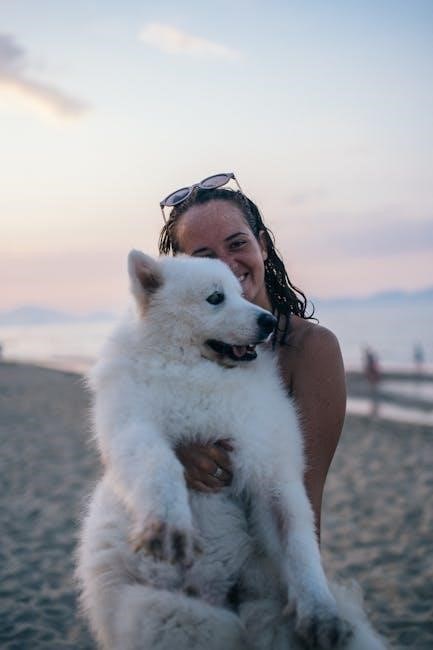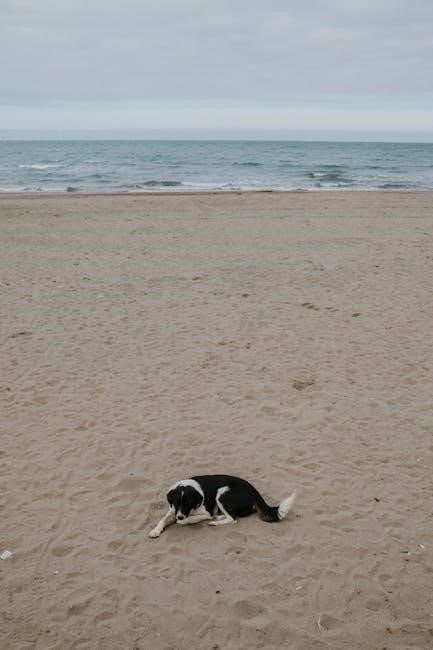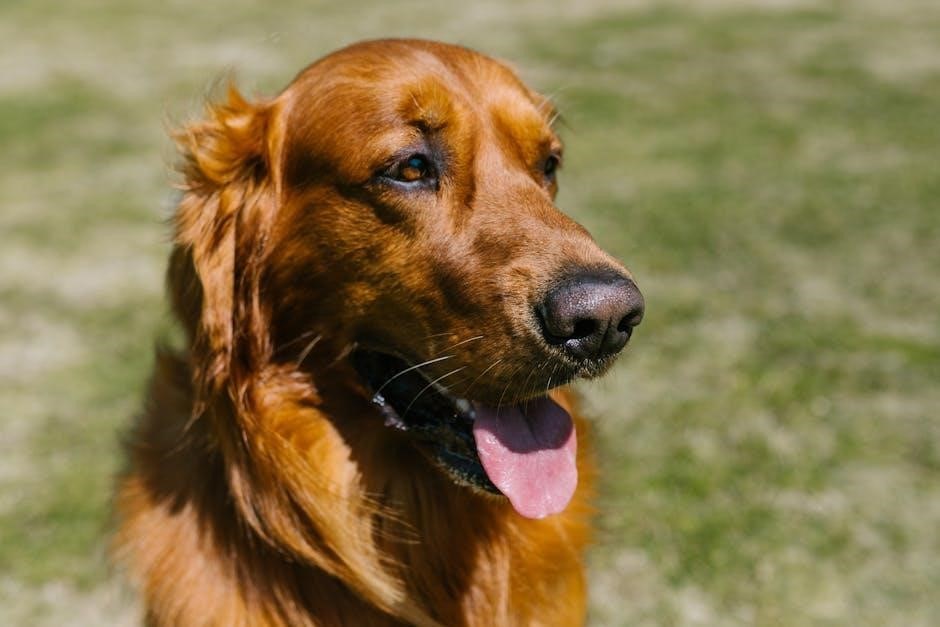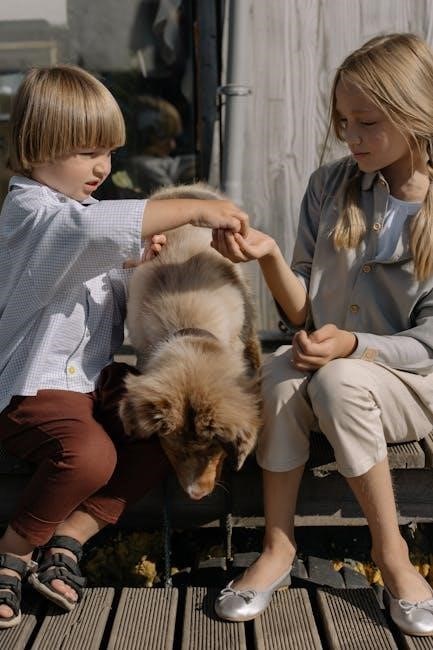
Title
Perfect Puppy in 7 Days: A Comprehensive Guide to Raising a Well-Behaved and Happy Puppy
Perfect Puppy in 7 Days: A Comprehensive Guide
This guide provides a structured 7-day program to help new puppy owners establish good habits and a strong bond with their pup. From crate training to socialization, it covers essential topics like potty training, basic commands, and addressing behavioral challenges. With practical tips and a focus on positive reinforcement, this guide ensures a smooth transition for puppies into their new homes, promoting a happy and well-behaved companion.
- Coverage of crate training and potty training fundamentals.
- Addressing common challenges like chewing and separation anxiety.
Welcome to the Perfect Puppy in 7 Days guide, designed to help new puppy owners establish a strong foundation for their pup’s behavior and well-being. This structured program covers essential training topics, from crate training to socialization, ensuring a smooth transition for your puppy into their new home. Positive reinforcement and consistency are key to raising a happy, well-behaved companion.
2.1. The Importance of Early Puppy Training
Early puppy training is crucial for developing good behavior and preventing bad habits. Puppies learn quickly, and the first few months set the foundation for their adult behavior. Through consistency and positive reinforcement, you can shape a well-adjusted, obedient companion. Addressing needs like potty training and socialization early ensures a smoother transition into their new home and strengthens your bond. Start training today for a lifetime of happiness together.
2.2. Overview of the 7-Day Training Program
This structured 7-day program guides you through essential puppy training. Day 1 focuses on crate training and basic commands. Days 2 and 3 cover potty training, socialization, and leash introduction. Advanced commands and addressing behavioral issues follow mid-week. The final days strengthen bonding and reinforce learning. Each day builds on the last, ensuring a comprehensive foundation for your puppy’s development. Consistency and positive reinforcement are key to success.

Preparing for Your Puppy’s Arrival
Ensure a smooth transition by gathering essential supplies like crates, toys, and leashes. Understand your puppy’s basic needs, including nutrition, sleep, and exercise, to create a welcoming environment.
3.1. Essential Supplies for a New Puppy
Stock up on a crate, comfortable bedding, chew-resistant toys, a leash, and an ID tag. Provide food and water bowls, a high-quality puppy diet, and a feeding puzzle for mental stimulation. Include grooming tools like a brush and nail clippers. Puppy-proof your home with baby gates and secure toxic substances. These essentials ensure safety, comfort, and a smooth transition for your new furry friend.
3.2. Understanding Your Puppy’s Basic Needs
Understanding your puppy’s basic needs is crucial for their development. Provide high-quality nutrition, fresh water, and regular feeding schedules. Ensure adequate sleep and exercise through playtime and walks. Stimulate their mind with interactive toys and training. Social interaction with people and dogs aids in proper development. Create a routine and safe environment to meet these needs, fostering a happy and healthy puppy.
Day 1: Crate Training and Basic Commands
Introduce crate training to establish boundaries and safety. Begin with simple commands like “sit” and “stay,” using positive reinforcement for effective learning and consistency.
Crate training is a useful tool for establishing boundaries and providing a safe space for your puppy. It helps with potty training, reduces separation anxiety, and prevents destructive behavior. Introduce the crate gradually, making it a comfortable environment with toys and treats. Start with short periods and increase duration as your puppy adjusts. Consistency and positive reinforcement are key to successful crate training, ensuring your puppy feels secure and calm.
4.2. Teaching Basic Commands Like “Sit” and “Stay”
Teaching basic commands like “sit” and “stay” establishes communication and sets the foundation for further training. Start with “sit” by holding a treat above your puppy’s head and moving it backward; As they follow with their nose, their bottom will lower into a sitting position. Reward with the treat and praise. For “stay,” begin with your puppy in a sitting position, take a few steps back, and return to reward them. Gradually increase distance and duration, ensuring consistency and positive reinforcement for successful learning.
Day 2: Potty Training Fundamentals
Potty training begins with consistency and supervision. Establish a schedule, watch for signs, and reward successful outings. Positive reinforcement and patience are key to progress.
5.1. Establishing a Potty Training Schedule
A consistent schedule is crucial for successful potty training. Take your puppy outside immediately after meals, naps, and playtime. Puppies thrive on routine, so sticking to specific times helps them learn. Watch for signs like sniffing or circling, and use a designated command like “go potty” to associate the action. Reward successes with praise and treats to reinforce good behavior. Over time, your puppy will learn to go where and when you want.
5.2. Positive Reinforcement Techniques
Positive reinforcement is a powerful tool for potty training. Reward your puppy with treats, praise, or playtime immediately after they eliminate correctly. Consistency is key—use the same command, like “go potty,” to help them associate the action. Over time, your puppy will learn to perform the desired behavior without rewards. This method builds trust and strengthens your bond, making training more effective and enjoyable for both you and your puppy.
Day 3: Socialization and Leash Training
Day 3 focuses on socialization and leash training. Socialization introduces your puppy to new people, dogs, and environments, ensuring confidence and calmness. Leash training teaches your puppy to walk beside you without pulling, using positive reinforcement techniques like treats and praise to encourage good behavior. This day lays the foundation for a well-adjusted and obedient companion.
6.1. Socializing Your Puppy with People and Dogs
Socializing your puppy with people and dogs is crucial for their development. Introduce your puppy to various environments, people, and dogs to build confidence and calmness. Use positive reinforcement techniques like treats and praise to encourage good behavior. Start with short, controlled interactions to prevent overwhelming your puppy. Proper socialization helps your puppy grow into a well-adjusted and friendly adult dog, reducing anxiety and aggression issues later in life.
Introduce leash walking by starting in a quiet, distraction-free area. Use a comfortable, well-fitted harness and a lightweight leash. Reward your puppy with treats and praise for walking calmly by your side. Gradually increase exposure to busier environments, teaching your puppy to focus on you despite distractions. Keep the leash slack, and avoid pulling, as this can create negative associations. Consistency and patience are key to developing good leash manners.

Day 4: Advanced Commands and Tricks
Teach commands like “come” and “down,” and introduce simple tricks to mentally stimulate your puppy. Use positive reinforcement to encourage quick learning and engagement.
7.1. Teaching Commands Like “Come” and “Down”
Start with “come” by using a leash and treats to encourage your puppy to return promptly. Gradually increase distance and distractions. For “down,” begin with your puppy in a “sit,” then lure their nose downward with a treat until they lie flat. Use positive reinforcement and consistent cues to help them learn these essential commands quickly and confidently.
7.2. Simple Tricks to Stimulate Your Puppy’s Mind
Mental stimulation is key to preventing boredom and destructive behavior. Start with simple tricks like “roll over” and “shake hands.” Use treats and praise to encourage learning. Introduce interactive toys or puzzle feeders to challenge your puppy. These activities not only entertain but also strengthen your bond and keep their mind active. Consistency and positive reinforcement are essential for successful trick training.
Day 5: Addressing Common Behavioral Issues
Day 5 focuses on tackling common puppy behaviors like excessive chewing, biting, and separation anxiety. Positive reinforcement and structured routines help address these challenges effectively.
8.1. Managing Chewing and Biting
Puppies often chew and bite due to teething pain or curiosity. Redirect their attention to durable toys or teething aids. Supervise playtime to prevent destructive behavior. Consistently replace inappropriate items with puppy-safe alternatives. Positive reinforcement, such as praising calm behavior, helps curb biting. Providing plenty of exercise and mental stimulation reduces chewing impulses. Establishing clear boundaries and routines ensures your puppy learns what is acceptable.
8.2. Reducing Separation Anxiety
Separation anxiety in puppies can be eased by gradual separation and consistent routines. Start with short absences, using a calm tone and a command like “stay.” Positive reinforcement, such as treats or praise, encourages confidence. Provide mental stimulation, like puzzle toys, to distract your puppy. Avoid dramatic goodbyes or hellos to prevent triggering anxiety. Consistent training and a predictable schedule help build trust and reduce stress when you’re away.
Day 6: Strengthening the Bond with Your Puppy
Engage in interactive play and mental stimulation to deepen your connection. Trust-building activities, like gentle grooming, foster closeness. Positive reinforcement with praise and treats strengthens your bond, creating a lifelong friendship.
9.1. Playtime and Interactive Activities
Engage your puppy in fun activities like fetch, tug-of-war, and hide-and-seek to promote physical and mental stimulation. Interactive toys, such as puzzle feeders, challenge problem-solving skills. Positive reinforcement techniques, like treats and praise, encourage good behavior. Playtime helps build trust and strengthens your bond, creating a foundation for a lifelong, joyful relationship with your puppy.
9.2. Building Trust Through Positive Interactions
Positive interactions are key to establishing trust with your puppy. Use gentle, consistent actions and calm energy to create a safe environment. Offer treats during training sessions and playful moments to reinforce positive associations. Avoid punishment, as it can lead to fear. Regular, loving interactions build a strong bond, helping your puppy feel secure and confident in your presence, fostering a trusting relationship.

Day 7: Finalizing Training and Maintenance
Reinforce all learned behaviors and introduce long-term care strategies. Consistency and positive reinforcement are key to maintaining progress. Celebrate successes and prepare for continued growth.
10.1. Reinforcing Learned Behaviors
Consistency is key to reinforcing your puppy’s training. Practice commands daily, using positive reinforcement like treats and praise. Gradually phase out rewards as your puppy becomes reliable. Integrate training into daily routines, such as before meals or walks. Celebrate milestones to motivate both you and your puppy. Patience and repetition will solidify their understanding and ensure long-term success. Keep sessions short and fun to maintain engagement.
10.2. Long-Term Training and Care Tips
For long-term success, continue challenging your puppy with advanced commands and tricks. Provide mental and physical stimulation through interactive toys and regular exercise. Schedule regular vet check-ups to monitor health. Maintain a balanced diet tailored to their life stage and breed. Create a safe environment by puppy-proofing your home. Consistently reinforce good behavior and adapt training as your puppy grows. Positive reinforcement remains key to a well-adjusted, obedient companion.

Common Challenges and Solutions
Address separation anxiety and destructive behavior by using positive reinforcement techniques like calming aids and consistent exercise. Provide mentally stimulating activities to prevent boredom and stress.
11.1. Overcoming Housebreaking Setbacks
Housebreaking setbacks are common, but consistency is key. Review your schedule and environment to identify triggers. Use positive reinforcement for successful potty breaks and clean accidents without punishment. Crate training can help prevent accidents when supervision isn’t possible. Stay patient and adjust routines as needed to reinforce good habits and overcome challenges effectively.
11.2. Managing Hyperactivity and Destructive Behavior
Hyperactivity and destructive behavior often stem from excess energy and lack of stimulation. Increase physical activity with playtime and walks, and engage their mind with interactive toys. Use positive reinforcement to redirect unwanted behavior, and set clear boundaries. Consistency is key to helping your puppy calm down and focus. Provide durable chew toys to prevent damage and ensure adequate rest to avoid overstimulation. Patience and structure will help curb these habits effectively.
The 7-day program sets a strong foundation for your puppy’s growth. Stay consistent, patient, and positive. Celebrate small milestones and enjoy the journey of raising a well-behaved companion.
12.1. Summary of Key Takeaways
Consistency, patience, and positive reinforcement are crucial for successful puppy training. From crate training to socialization, each day builds a strong foundation. Addressing behavioral issues early and reinforcing good habits ensures long-term success; Stay committed, celebrate milestones, and nurture a lifelong bond with your puppy. This comprehensive guide equips you with practical tools to raise a well-behaved and happy companion.
12.2. Encouragement for Continued Training
Remember, training is a lifelong journey with your puppy. Celebrate small victories and stay patient as your puppy grows. Every effort you make strengthens your bond and shapes a well-adjusted, obedient companion. Keep adapting to their needs and exploring new activities to keep them engaged. The rewards of continued training are immeasurable, leading to a happier, healthier relationship with your furry friend.
Leave a Reply
You must be logged in to post a comment.